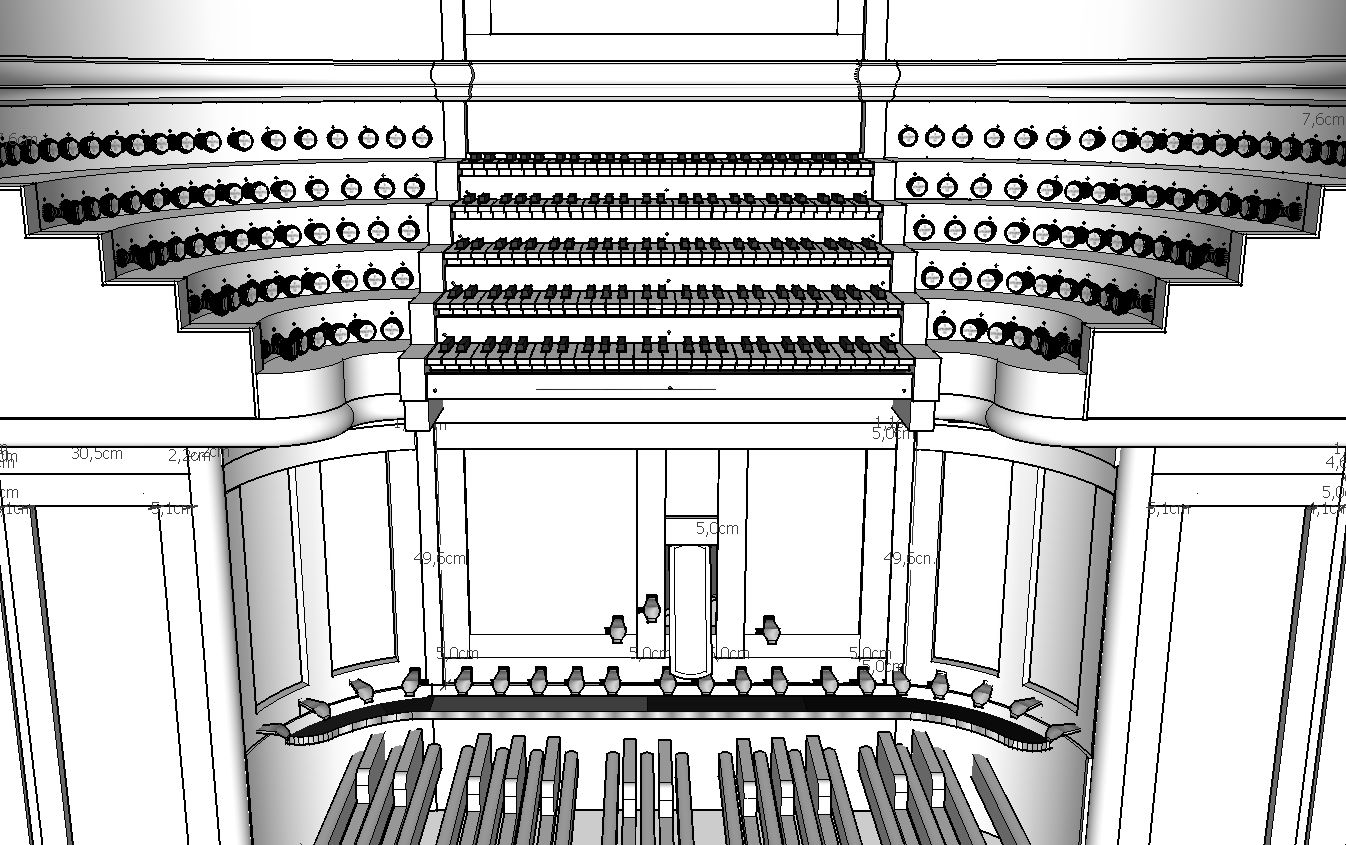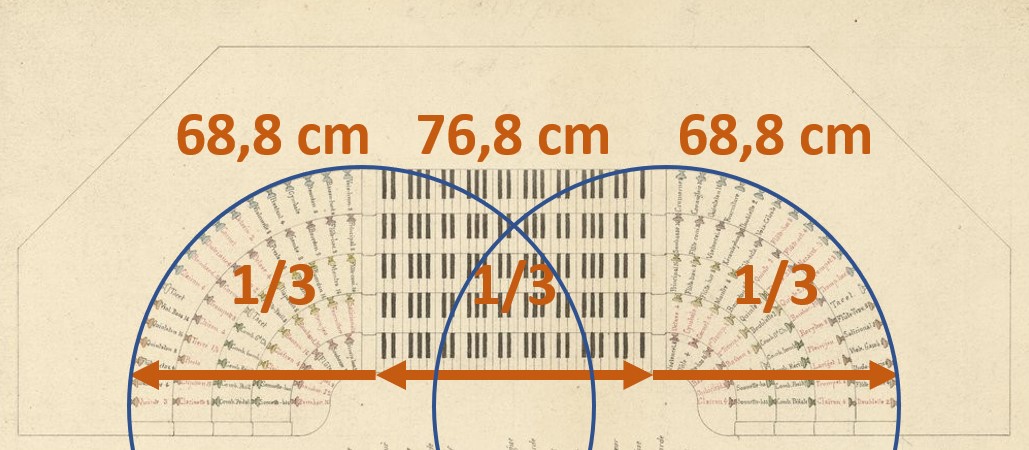

 © sketch by A. Cavaillé-Coll of Saint Sulpice console | source: gallica.bnf.fr:ark:/12148/btv1b53031174j/puplic domain © sketch by A. Cavaillé-Coll of Saint Sulpice console | source: gallica.bnf.fr:ark:/12148/btv1b53031174j/puplic domain |
||
Cavaillé-Coll Study Instrument | The New Project | Measurements | The Sketching Process | The Terrasses | The Base of the Console | Draw knop stops | The Cavaillé-Coll Logo | Building the Pedale | The Appel-System | Electrification | The Study Cabinet | The Final Result |
REPLICA OF SAINT SULPICE CONSOLEThe Perfect Cavaillé-Coll Study InstrumentIt is fair to say, that the great Cavaillé-Coll console of Saint Sulpice appears to be one of the most unique inventions of the organ builder. Countlessly copied and since than a fixed icon of modern organ building, it was never reached again, as any invention evolves naturally from the art of a genius while the copy will be frankly just and only that. Nevertheless, since I have studied the French romantic and modern organ repertoire with Ben van Oosten, Marie-Claire Alain and Susan Landale up to a concert master degree, I always hoped to have one day my own Cavaillé-Coll console of some sort at least, to work myself through the historic practise and art of performance more deeply. If one is taking this seriously, you may need the perfect Cavaillé-Coll study instrument at a limitless availability being after all a nearly impossible aim. THE NEW PROJECT Unless and therefore, I decided to start this new project of building a Cavaillé-Coll console featuring the specification and composition of Saint Sulpice pipe organ using the sampleset of Mr. Evert-Jan van der Leij and Martin den Boer who both did a fantastic and inspiring job in reconstructing the console brilliantly. They showed, that it can be done, so it will be done. Being besides that a very hard task in so many ways and aspects, especially if you do everything on your own, it is a challenge in ingenuity, determination and persistence, I'd like to accomplish. The last statement indicates obviously the reason why I did not choose the smaller approach just as the console of Saint Ouen de Rouen or the console of Saint Sernin in Toulouse. The challenge and personal ambition rules the idea and would otherwise take the fun out of it.  The general sketch of the Cavaillé-Coll console replica of Saint Sulpice including the French appel-system as it appeared at the console of Notre Dame actually than at Saint Sulpice MEASUREMENTS As a starting point, I needed the measurements of the console, which are hard to come by. But there is a general assumption: if you look at photographs especially from above, you may recognize that the width of the keyboards appears to be nearly the same with the large circle of the terrasses. Both circles are excactly placed within the golden rule or golden cut to the keyboards. The keyboards width is normaly 78cm plus the manual frame and the normal length of an arm ranges between 62cm to 68cm. That is surely what Cavaillé-Coll had in mind when constructing the console: all stops should be within the range of an arm.  measurements assumptions of the Cavaillé-Coll console replica of Saint Sulpice | the sketch was made by Cavaillé-Coll himself The Sketching Process From there the 3D modelling is more or less clear. Nevertheless, if you may look at the drawing of the original Saint Sulpice console sketch by Cavaille Coll more closely, you can see that in the end it was necessary to move the manuals section foreward. Otherwise it would no longer be in the same plane as the pedal. This is one of the many hidden design problems with this console. Changing the position of the manual relative to the register blocks has a direct impact on the position of the pedal and the position of the playing aids and footrests. This very circumstance would cause me the greatest difficulties in the further course of the work. This also results in the distance between the base of the console and the register section approximately at the depth of the third terrace and therefore corresponds to the third terrace arch. Well, I made some sketches realizing, that the console will be too large for the space I have. Generally, you will need 2,8 meters for the whole thing. The first decision made was to reduce the size of the console a little bit down to 2,2 meters, leaving out every not functional aspect of the design. Finally, I will work with 64,4 cm not with 68,8 cm. The terrasses will be each one centimetre short from the original and will be cut just there. There are no solenoids, but just a mechanic action to pull out the stops 1,5cm. That's entirely sufficient. The second decision was to build an additional wooden study-cabinet entirely isolated in order to prevent the sound from reaching out. The console will not be a free standing one but caged in a study.
Another discussion lasted quite long: LED-sequncer-system, solenoids or just mechanic action? Finally I decided in favour to the last option. To have the console in an entirely mechanical setting without any kind of sequencer except the one combination system Cavaillé-Coll implemented himself, seems to me a crucial decision to justify the whole project. Having a sequencer system at hand will jeopardize the practise and learning process questioning the effort in itself. Although this seems to be a honorable statement, the practical reason is much more at hand. It is just far to difficult, space consuming and expensive to implement a self-action sequencer and as you always able to use the console from a touch-screen level there is just no need for solenoids. On the other hand, it obviously makes concert preparation and the general practice process more difficult. Compromises will certainly be made here, but these are primarily linked to whether it is possible to obtain sufficient quantities of electromagnets. By now, I have managed to build up the five manuals and will proceed in building the lower case first. As you can see, the third decision was to focus a bit more on the design of the former Cavaillé-Coll console of Notre Dame in Paris but to the console of Saint Sulpice itself. The balanced swell shoe is a compromise. To implement in Hauptwerk software a French trigger swell will be too hard and for practise proposes even too sophisticated. But honestly, I am still wondering if it can be done, so that the console will have a balanced swell shoe centred and on the right-hand side a trigger swell. We’ll see. The draw knop stops are still in a development process as I have not yet decided whether to wooden turn them or to pour them in epoxide. But I first tried the turn option. Here some results. I will keep you informed about the process of the project hoping to inaugurate the console on youtube very soon. THE TERRASSES Constructing the terrasses was particularly difficult, not only because of measurements but also in fact of cutting them properly. There is a very large gap between sketching and proceeding wood perfectly. There is realy no point in a perfect construction plan if you are unable to build that to at least some acceptable perfection. After some frustrating results I decided to cut all the parts via CNC, guessing this honestly while looking back to be the only way of achieving a functional result. Finally, I managed to create a sketch containing all parts of the terrasses, which from there just needed to be glued together. The plywood was finished with oak veneer. This was also cut using CNC. Here are the sketches of the CNC parts and the final result of the process. The next difficulty was bending the solid oak wood. This requires certain temperatures, hot air and some moisture. Of course, by the time you get the right mixing ratio, a lot of wood will have broken through. Ultimately I decided on a veneer concept here too. Veneer is much easier to bend and looks just as good as solid wood. However, it breaks much more easily when drilling, so making the holes for the register pulls took a few tries, either. But I think the end result makes up for the many failed attempts. THE BASE OF THE CONSOLE To build the base of the organ console, there were several considerations that constantly changed over time. Initially, I worked with a width of 218 cm. However, the location of the console also changed, so I had more space available and consequently had to calculate with 240 cm. The construction was therefore always flexible and subject to change. Ultimately, I had the main construction panels cut using CNC. It's almost impossible to cut wood perfectly round with standard hardware store machines. So, after several attempts, this was the best option. The side doors of the console were, of course, no problem. Here, I simply used plywood panels covered with oak veneer. The solid oak frame was then glued accordingly, and the decorative strips were cut to size. Creating the curves was much more difficult. Here, too, I had to try out several methods until I finally achieved a satisfactory result. Some examples of the bends of the wood After realizing that CNC is a great resource for so many aspects of the project, I turned to the Logo of Cavaillé-Coll that needed to be graved into. Since designing a vector graphic, the result was brilliant and was filled in with epoxide gold containing cold metal gold pigments.
|